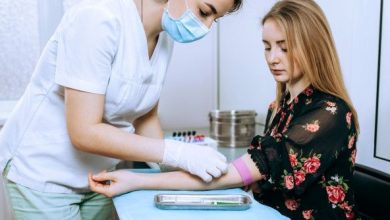Natural And Herbal Treatment For Polycythemia Vera

This is a slow–growing blood cancer in which the bone marrow makes too many red blood cells. When you have excess cells, then they thicken your blood and slow its flow. Also, they can cause complications and this leads to stroke or heart attack. This is not a very common disease. Usually, polycythemia vera develops slowly and many people have it without knowing that they have. Herbal Treatment for polycythemia vera can be effective to get rid of the conditions.
The most common signs and symptoms of polycythemia vera include blurred vision; fatigue; weakness; bleeding or bruising, usually minor; dizziness; headache; itchiness, especially following a warm bath or shower; excessive sweating; unexplained weight loss; fevers; a feeling of fullness or bloating in your left upper abdomen due to an enlarged spleen; shortness of breath; painful swelling of one joint, often the big toe. This condition can happen at any age but it is most common in adults who are older than 60. Blood clots can cause a heart attack, a stroke, or a blockage in your lungs or in a vein deep within a muscle. Also, when you have polycythemia vera, then it can make your spleen work harder than normal which is causing it to enlarge.
Related Article; Exploring Polycythemia Vera Alternative Treatments: Natural Approaches to Managing Symptoms
When you have too many red blood cells, then it can lead to a number of other complications, including inflammation in your joints, upper small intestine, or esophagus and there can be open sores on the inside lining of your stomach. You should know that polycythemia vera is a chronic condition that cannot be cured. The treatment of this condition is focusing on reducing your amounts of blood cells.
There are many cases when the treatment can reduce the risk of complications from polycythemia vera and it can ease the signs and symptoms. If you suffer from polycythemia vera, then you should talk with your doctor before you start using some of the below-mentioned Home Remedies for Polycythemia Vera so in this way you will avoid side effects.
Related Article; Natural Remedies for Polycythemia Vera: Proper Way to Lessen the Symptoms

Home Remedies for Polycythemia Vera
Watch your sores:
It is known that poor circulation can make it difficult for sores to heal, particularly on your hands and feet. You should inspect your feet regularly and you should tell your doctor if you have any sores. Those people who have polycythemia vera commonly have non – healing sores, such as scrapes or bruises which are caused by normal activities, and they very slowly heal.
The slowed blood flow in people with polycythemia Vera delays the healing process of sores so minor sores can make a much longer time to heal than normal. You should look over your body regularly if you have polycythemia vera to know if you have any new sore. Feet are very prone to sores so you should check your feet frequently. You should talk with your doctor if you have found any new sores. You should take extra care with your sores until they are healed. You should bandage them carefully and you should try not to bump them.
Related Article; Natural Remedies for Polycythemia Vera Reduce the Risk of Causes
Avoid extreme temperatures:
It is known that poor blood flow is increasing your risk of injury from hot and cold temperatures. You should take measures to protect yourself from extreme temperatures. If the weather is hot, then you should protect yourself from the sun and drink a lot of liquids. You should wear things like visors to protect yourself from the sun during hot days. Also, you should use sunscreen when you go out in the sun. If the weather is cold, then you should always wear warm clothing, particularly on your hands and feet. [1,2]
Healthy diet:
It is very important to eat a healthy diet for the Herbal Treatment for Polycythemia Vera if you suffer from this condition. You should eat a low–fat diet in sensible portions with legumes, grains, fruits, and vegetables.
Related Article; Natural Herbal Remedies for Polycythemia Vera Treatment
Garlic:
It is recommended to eat two to three raw garlic cloves in the morning on an empty stomach because it can help in the Herbal Treatment for Polycythemia Vera.
Do not smoke:
It is very important not to smoke or chew tobacco if you suffer from polycythemia vera. It is known that tobacco can make your blood vessels narrow and this can increase your risk of getting stroke or heart attack due to blood clots. Also, if you smoke cigarettes, you should stop smoking as soon as possible because smoking can make the symptoms of polycythemia Vera worse. You should talk with your doctor about quitting smoking if you cannot do it on your own.
You should make an appointment with your doctor to make an action plan for quitting smoking. There are some people who quit cold turkey while others quit gradually. Also, your doctor can suggest medications that can help you to quit. Also, you should seek support. You can find a support group for people who quitting smoking at your local hospital. If there is not a support group in your local area, then you can find it online. This will help you a lot and you will be in contact with other people who have the same problem as you. [3]
Related Article; Treatment Update : Polycythemia Vera
Cayenne:
You should mix one teaspoon of cayenne pepper powder with one glass of warm water and drink this one of the effective Herbal Remedies for Polycythemia Vera on daily basis.
Seek emotional support:
We know that polycythemia vera is a type of cancer and any type of cancer can be difficult on an emotional level. You are treating your physical symptoms but also it is very important to treat your emotional ones. You should seek support from your friends and loved ones because they can help you to cope during this difficult period of your life. You should talk with your friends and family members about how you feel. You should ask them to let you vent on occasion if you are feeling frustrated, scared, or otherwise down. Also, you should see if there is a cancer support group online or in your local area. If you are feeling very depressed or stressed about your diagnosis, then you may benefit from professional counseling. [4]
Aloe Vera:
You can use Aloe Vera as your Natural Remedies for Polycythemia Vera. You should consume one teaspoon of freshly extracted pulp from Aloe Vera leaf in the morning.
Treat itchy skin:
Those people who have polycythemia vera can have itchy skin which is a major problem for them. There are many different ways to minimize and treat itchiness at home if itchiness is a problem for you. You should use lotions and other moisturizers on a regular basis, especially when your skin is dry and itchy. They can help to hydrate your skin and it will lessen the itchiness. This is the best Natural Treatment for Polycythemia Vera option to get rid of this.
Related Article; Polycythemia Vera – A Blood Disorder
You should use warm water when you are bathing or showering because the heat can make itchiness worse, so you should avoid hot showers, hot tubes, and other exposures to hot water. You should always pat dry your skin after taking a shower or bath. When you are rubbing your skin, then it can make your itchiness worse. After you get out of the shower, you should use a clean towel to gently pat water off of your skin. You should avoid scratching when you are itchy. This can make your itchiness worse and it can increase your risk for an infection. You should trim your nails very short or wear gloves or mittens during the day because this can reduce the temptation to itch.
Talk with your doctor about your physical activity:
Many doctors consider physical activity safe for people who suffer from polycythemia vera. But if you have developed some complications caused by polycythemia vera, like an enlarged spleen, then you may have to avoid things like contact sports. You should discuss safe physical activity each time you see your doctor. It is known that walking can help with side effects, such as fatigue because it can help with blood circulation. You should talk with your doctor if walking is a safe option for you. [5]
Stay hydrated:
It is very important to stay hydrated if you suffer from polycythemia vera. It is known that dehydration can make your condition worse so you should drink enough amount of water. You should always wear a water bottle with you. Stay hydrated is the Polycythemia Vera Natural Treatment to get relief from it.
Be good to your skin:
If you want to reduce the itching, then you should bathe in cold water and use a gentle cleanser to pat your skin dry. When you are adding starch, such as cornstarch to your bath, then it can help. You should avoid hot tubes, hot showers, hot baths, and heated whirlpools. You should try not to scratch because it can damage your skin and can increase your risk of infection. You should use lotion to keep your skin moist.
Exercise:
It is known that moderate exercises, such as walking, can improve your blood flow and this can decrease your risk of blood clots. Ankle and leg stretch and exercises can improve your blood circulation. [5]




